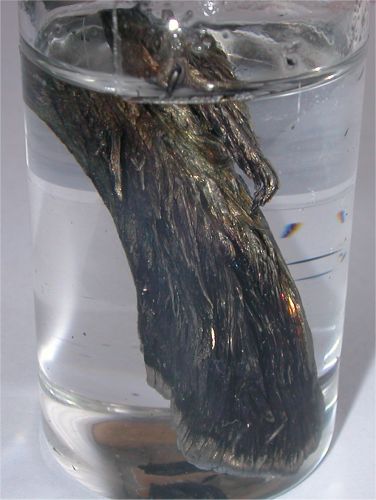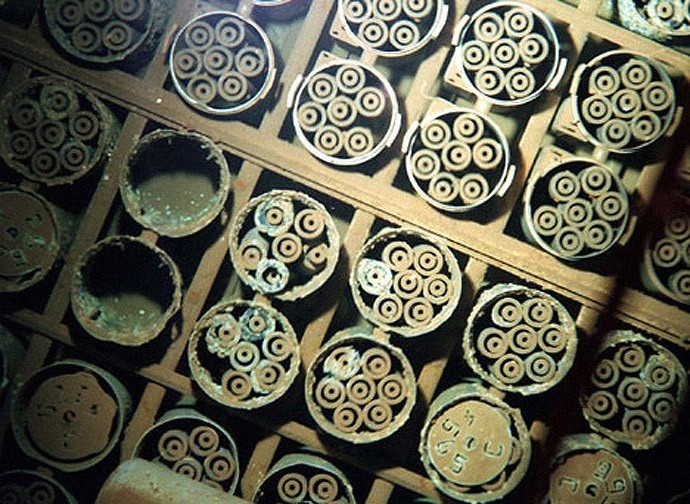|
Strontium-90
Strontium-90 () is a radioactive isotope of strontium produced by nuclear fission, with a half-life of 28.79 years. It undergoes β− decay into yttrium-90, with a decay energy of 0.546 MeV. Strontium-90 has applications in medicine and industry and is an isotope of concern in fallout from nuclear weapons, nuclear weapons testing, and nuclear accidents. Radioactivity Naturally occurring strontium is nonradioactive and nontoxic at levels normally found in the environment, but 90Sr is a radiation hazard. 90Sr undergoes β− decay with a half-life of 28.79 years and a decay energy of 0.546 MeV distributed to an electron, an antineutrino, and the yttrium isotope 90Y, which in turn undergoes β− decay with a half-life of 64 hours and a decay energy of 2.28 MeV distributed to an electron, an antineutrino, and 90Zr (zirconium), which is stable. Note that 90Sr/Y is almost a pure beta particle source; the gamma photon emission from the decay of 90Y is so infrequen ... [...More Info...] [...Related Items...] OR: [Wikipedia] [Google] [Baidu] |
Nuclear Fallout
Nuclear fallout is residual radioactive material that is created by the reactions producing a nuclear explosion. It is initially present in the mushroom cloud, radioactive cloud created by the explosion, and "falls out" of the cloud as it is moved by the atmosphere in the minutes, hours, and days after the explosion. The bulk of the radioactivity from nuclear fallout comes from fission products, which are created by the nuclear fission reactions of the nuclear device. Un-fissioned bomb fuel (such as plutonium and uranium), and radioactive isotopes created by neutron activation, make up a smaller amount of the radioactive content of fallout. The amount of fallout and its distribution is dependent on several factors, including the overall yield of the weapon, the fission yield of the weapon, the height of burst of the weapon, and meteorological conditions. Fallout can have serious human health consequences on both short- and long-term time scales, and can cause radioactive conta ... [...More Info...] [...Related Items...] OR: [Wikipedia] [Google] [Baidu] |
Strontium
Strontium is a chemical element; it has symbol Sr and atomic number 38. An alkaline earth metal, it is a soft silver-white yellowish metallic element that is highly chemically reactive. The metal forms a dark oxide layer when it is exposed to air. Strontium has physical and chemical properties similar to those of its two vertical neighbors in the periodic table, calcium and barium. It occurs naturally mainly in the minerals celestine and strontianite, and is mostly mined from these. Both strontium and strontianite are named after Strontian, a village in Scotland near which the mineral was discovered in 1790 by Adair Crawford and William Cruickshank; it was identified as a new element the next year from its crimson-red flame test color. Strontium was first isolated as a metal in 1808 by Humphry Davy using the then newly discovered process of electrolysis. During the 19th century, strontium was mostly used in the production of sugar from sugar beets (see strontian proces ... [...More Info...] [...Related Items...] OR: [Wikipedia] [Google] [Baidu] |
Radioactive Waste
Radioactive waste is a type of hazardous waste that contains radioactive material. It is a result of many activities, including nuclear medicine, nuclear research, nuclear power generation, nuclear decommissioning, rare-earth mining, and nuclear weapons reprocessing. The storage and disposal of radioactive waste is regulated by government agencies in order to protect human health and the environment. Radioactive waste is broadly classified into 3 categories: low-level waste (LLW), such as paper, rags, tools, clothing, which contain small amounts of mostly short-lived radioactivity; intermediate-level waste (ILW), which contains higher amounts of radioactivity and requires some shielding; and high-level waste (HLW), which is highly radioactive and hot due to decay heat, thus requiring cooling and shielding. Spent nuclear fuel can be processed in nuclear reprocessing plants. One third of the total amount have already been reprocessed. With nuclear reprocessing 96% of the spent fue ... [...More Info...] [...Related Items...] OR: [Wikipedia] [Google] [Baidu] |
Nuclear Reactor
A nuclear reactor is a device used to initiate and control a Nuclear fission, fission nuclear chain reaction. They are used for Nuclear power, commercial electricity, nuclear marine propulsion, marine propulsion, Weapons-grade plutonium, weapons production and Research reactor, research. Fissile material, Fissile nuclei (primarily uranium-235 or plutonium-239) absorb single neutron, neutrons and split, releasing energy and multiple neutrons, which can induce further fission. Reactors stabilize this, regulating Neutron absorber, neutron absorbers and neutron moderator, moderators in the core. Fuel efficiency is exceptionally high; Enriched uranium#Low-enriched uranium (LEU), low-enriched uranium is 120,000 times more energy dense than coal. Heat from nuclear fission is passed to a working fluid Nuclear reactor#By coolant, coolant. In commercial reactors, this drives Turbine, turbines and electrical generator shafts. Some reactors are used for district heating, and isotopes, isoto ... [...More Info...] [...Related Items...] OR: [Wikipedia] [Google] [Baidu] |
Yttrium-90
Yttrium-90 () is a radioactive isotope of yttrium. Yttrium-90 has found a wide range of uses in radiation therapy to treat some forms of cancer Cancer is a group of diseases involving Cell growth#Disorders, abnormal cell growth with the potential to Invasion (cancer), invade or Metastasis, spread to other parts of the body. These contrast with benign tumors, which do not spread. Po .... Along with other isotopes of yttrium, it is sometimes called radioyttrium. Decay undergoes beta particles emissions/decay (beta decay, β− decay) to zirconium-90 with a half-life of 64.1 hours and a decay energy of 2.28 MeV with an average beta energy of 0.9336 MeV. It also produces 0.01% 1.7 MeV photons during its decay process to the 0+ state of 90Zr, followed by pair production. The interaction between emitted electrons and matter can lead to the emission of Bremsstrahlung radiation. Production Yttrium-90 is produced by the nuclear decay of strontium-90 which has a half-l ... [...More Info...] [...Related Items...] OR: [Wikipedia] [Google] [Baidu] |
Beta Particle
A beta particle, also called beta ray or beta radiation (symbol β), is a high-energy, high-speed electron or positron emitted by the radioactive decay of an atomic nucleus, known as beta decay. There are two forms of beta decay, β− decay and β+ decay, which produce electrons and positrons, respectively. Beta particles with an energy of 0.5 MeV have a range of about one metre in the air; the distance is dependent on the particle's energy and the air's density and composition. Beta particles are a type of ionizing radiation, and for radiation protection purposes, they are regarded as being more ionising than gamma rays, but less ionising than alpha particles. The higher the ionising effect, the greater the damage to living tissue, but also the lower the penetrating power of the radiation through matter. Beta decay modes β− decay (electron emission) An unstable atomic nucleus with an excess of neutrons may undergo β− decay, where a neutron is converted into a proto ... [...More Info...] [...Related Items...] OR: [Wikipedia] [Google] [Baidu] |
Yttrium
Yttrium is a chemical element; it has Symbol (chemistry), symbol Y and atomic number 39. It is a silvery-metallic transition metal chemically similar to the lanthanides and has often been classified as a "rare-earth element". Yttrium is almost always found in combination with lanthanide elements in rare-earth minerals and is never found in nature as a free element. 89Y is the only stable isotope and the only isotope found in the Crust (geology), Earth's crust. The most important present-day use of yttrium is as a component of phosphors, especially those used in LEDs. Historically, it was once widely used in the red phosphors in television set cathode ray tube displays. Yttrium is also used in the production of electrodes, electrolytes, electronic filters, lasers, superconductors, various medical applications, and Trace element, tracing various materials to enhance their properties. Yttrium has no known Biology, biological role. Exposure to yttrium compounds can cause Respiratory ... [...More Info...] [...Related Items...] OR: [Wikipedia] [Google] [Baidu] |
Isotopes Of Strontium
The alkaline earth metal strontium (38Sr) has four stable, naturally occurring isotopes: 84Sr (0.56%), 86Sr (9.86%), 87Sr (7.0%) and 88Sr (82.58%). Its standard atomic weight is 87.62(1). Only 87Sr is radiogenic; it is produced by decay from the radioactive alkali metal 87 Rb, which has a half-life of 4.88 × 1010 years (i.e. more than three times longer than the current age of the universe). Thus, there are two sources of 87Sr in any material: primordial, formed during nucleosynthesis along with 84Sr, 86Sr and 88Sr; and that formed by radioactive decay of 87Rb. The ratio 87Sr/86Sr is the parameter typically reported in geologic investigations; ratios in minerals and rocks have values ranging from about 0.7 to greater than 4.0 (see rubidium–strontium dating). Because strontium has an electron configuration similar to that of calcium, it readily substitutes for calcium in minerals. In addition to the four stable isotopes, thirty-two unstable isotopes of strontium are k ... [...More Info...] [...Related Items...] OR: [Wikipedia] [Google] [Baidu] |
Spent Nuclear Fuel
Spent nuclear fuel, occasionally called used nuclear fuel, is nuclear fuel that has been irradiated in a nuclear reactor (usually at a nuclear power plant). It is no longer useful in sustaining a nuclear reaction in an ordinary thermal reactor and, depending on its point along the nuclear fuel cycle, it will have different isotopic constituents than when it started. Nuclear fuel rods become progressively more radioactive (and less thermally useful) due to neutron activation as they are fissioned, or "burnt", in the reactor. A fresh rod of low enriched uranium pellets (which can be safely handled with gloved hands) will become a highly lethal gamma emitter after 1–2 years of core irradiation, unsafe to approach unless under many feet of water shielding. This makes their invariable accumulation and safe temporary storage in spent fuel pools a prime source of high level radioactive waste and a major ongoing issue for future permanent disposal. Nature of spent fuel Nanomaterial pro ... [...More Info...] [...Related Items...] OR: [Wikipedia] [Google] [Baidu] |
Specific Activity
Specific activity (symbol ''a'') is the activity per unit mass of a radionuclide and is a physical property of that radionuclide. It is usually given in units of becquerel per kilogram (Bq/kg), but another commonly used unit of specific activity is the curie per gram (Ci/g). In the context of radioactivity, activity or total activity (symbol ''A'') is a physical quantity defined as the number of radioactive transformations per second that occur in a particular radionuclide. The unit of activity is the ''becquerel'' (symbol Bq), which is defined equivalent to reciprocal seconds (symbol s−1). The older, non-SI unit of activity is the ''curie'' (Ci), which is radioactive decays per second. Another unit of activity is the ''rutherford'', which is defined as radioactive decays per second. The specific activity should not be confused with level of exposure to ionizing radiation and thus the exposure or absorbed dose, which is the quantity important in assessing the effects of ... [...More Info...] [...Related Items...] OR: [Wikipedia] [Google] [Baidu] |
Zirconium
Zirconium is a chemical element; it has Symbol (chemistry), symbol Zr and atomic number 40. First identified in 1789, isolated in impure form in 1824, and manufactured at scale by 1925, pure zirconium is a lustrous transition metal with a greyish-white color that closely resembles hafnium and, to a lesser extent, titanium. It is solid at room temperature, Ductility, ductile, malleable and corrosion-resistant. The name ''zirconium'' is derived from the name of the mineral zircon, the most important source of zirconium. The word is related to Persian Language, Persian ''Jargoon, zargun'' (zircon; ''zar-gun'', "gold-like" or "as gold"). Besides zircon, zirconium occurs in over 140 other minerals, including baddeleyite and eudialyte; most zirconium is produced as a byproduct of minerals mined for titanium and tin. Zirconium forms a variety of inorganic chemistry, inorganic compounds, such as zirconium dioxide, and organometallic compounds, such as zirconocene dichloride. Five isotope ... [...More Info...] [...Related Items...] OR: [Wikipedia] [Google] [Baidu] |



